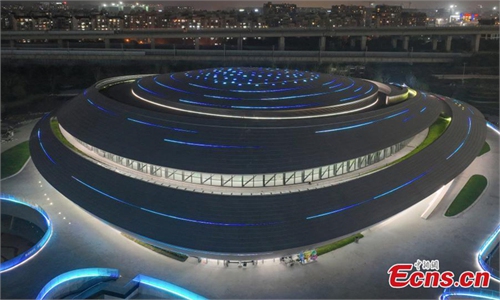
Aerial photo taken on April 23, 2017 shows a container wharf of Yangshan Port in Shanghai, East China. File Photo: Xinhua
Chinese ports, especially those located in the Yangtze River Delta, are staying resilient in operations to ensure the stability of the global supply chain while easing logistics disruptions caused by regional epidemic prevention needs.
Despite lingering challenges due to the severity of COVID-19 flare-up, progress has been made in the supply chain sector after the government smoothed traffic and helped business resumption for both domestic and overseas markets.
Industry experts said the recovery of the supply chain can be expected in mid-to-late May.
Data from the Ministry of Transport on Tuesday showed that there were 7.196 million trucks on and off expressways nationwide, a month-on-month increase of 7.72 percent as China's freight logistics continued to maintain a recovery trend.
With road traffic, the hinge of the overall supply chain, picking up, ports operations are also slowly recovering.
China's major ports handled 725,000 standard containers worth of goods on Monday, down 0.1 percent from the previous month, which experts said is a sign of anticipated recovery.
Industry representatives said that the overall supply chain is easing, which is reflected in the resilience of Shanghai port, the world's largest container port by throughput.
In a statement that international shipping conglomerate Maersk sent to the Global Times on Tuesday, the company said that "we have seen an improvement in pickups for both export empty containers and import-laden ones. We have resumed the booking acceptance of Dangerous Cargo enabled by terminals having managed to release more space for reefers and DG Cargo by optimizing internal layouts."
The company is extending customer relief options to the end of April in this regard in order to help them cope with the ongoing logistics challenges, it said.
Earlier this month, several large shipping companies including Maersk announced that dangerous goods and refrigerated containers would not be unloaded, due to the high utilization rate of some storage yards in the Shanghai port, reminding customers to change their destinations.
"Local authorities are well aware of the landside bottlenecks caused by the situation and have urged all possible efforts to keep the supply chain moving and minimize the impact," Maersk said.
In diverting the pressure from Shanghai port while securing trade flows, other neighboring cities with ports are playing an increasingly key roles.
While Maersk is currently observing recovered landside volumes, barge and rail networks have encountered challenges to position empties at inland locations.
Alternative solutions are considered including multi-modal services between Shanghai and nearby cities, the company said.
Neighboring ports such as the Ningbo Zhoushan Port, in East China's Zhejiang Province, have taken more orders from Shanghai and saw an expected increase of waiting times for ships.
The average waiting time of main container lines in the Ningbo Zhoushan Port area, from Sunday to Tuesday, was 41.07 hours. As of Tuesday afternoon, 59 containerships were waiting at the Weizhi Port in Ningbo, according to data from the port.
So far this month, ships at Zhoushan Port were waiting for about 30 hours on average, an increase of 28.02 percent month-on-month.
In smoothing the supply chain and ensuring timely delivery of goods, Lianyungang Port, a major trade hub in East China's Jiangsu Province, has moved to ensure foreign trade flows by using domestic trade ships to deliver goods from factories to the port, in addition to the traditional road and train services
Moreover, due to similar supportive measures, in the first quarter, Ningbo Zhoushan Port completed cargo throughput of 303 million tons, a year-on-year increase of 3.4 percent while container throughput stood at 7.91 million standard containers, a year-on-year increase of 2.9 percent, data from the port administration of Zhejiang Province showed.
While Chinese ports are taking steps to smooth trade, some foreign media have criticized China for port congestion in the West.
The backlog of containers waiting to be unloaded at the US' Los Angeles and Long Beach ports last year is set to happen again due to China's "zero-tolerance" COVID policy, which has massively slowed down Shanghai port's container unloading as well as domestic production for exports, The Diplomat said, claiming that China's epidemic prevention policy would renew US West Coast port congestion.
Chinese experts refuted such allegations, especially when comparing port congestion in the US with that of China, calling it inappropriate comparison in terms of the gravity of the situation.
The congestion hurdle at the US ports has been there since last year, and the longest waiting time at ports could be up to a week, while the Shanghai port has been much better, Zhao Nan from the Shanghai International Shipping Research Center told the Global Times on Tuesday.
Moreover, the average port congestion index was 0.22 at the Shanghai port on Tuesday while the average amount of time ships spent at anchor was 5.67 hours, and the number of berthing vessels was 25, according to a report that Elane Inc, a Chinese pilot logistics information platform, sent to the Global Times on Tuesday.
Comparatively, the average congestion index of the Los Angeles and Long Beach ports was 0.46, and the average waiting time for ships at anchor was 12.89 hours, with 24 berthing vessels at ports, according to Elane Inc.
As the port and transportation authority continue to promote the restoration of the lifeline of foreign trade between factories and ports, the situation at China's ports should further improve, Zhong Zhechao, founder of One Shipping, an international logistics service consulting company, told the Global Times on Tuesday.
Zhong predicted that China's supply chain may start to normalise in mid-to-late May, with export shipments to heat up.



